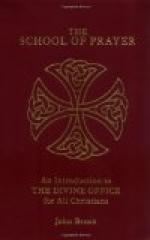But there is an earlier codex than those mentioned by Bishop, and from it, it is argued that the feast is of Irish origin. In a metrical calendar, which is reasonably referred to the time of Alfred the Great (871-901), there is the line “Concipitur Virgo maria cognomine senio”; and this calendar exhibits, says Father Thurston, S.J., “most unmistakable signs of the influence of an Irish character.” It was written, Dr. Whitely Stokes believed, by an Irishman in the ninth century or thereabouts. The script appears to him to be “old Irish, rather than Anglo-Saxon, and the large numbers of commemorations of Irish saints and the accuracy with which the names are spelt, point to an Irish origin.” This calendar places the feast of our Lady’s Conception on the 2nd May. In the metrical calendar of Oengus, the feast is assigned to the 3rd May, and in his Leabhar Breac, the scribe adds the Latin note, “Feir mar Muire et reliqua, i.e., inceptio ejus ut alii putant—sed in februo mense vel in Martio facta est illa, quae post VII. menses nata est, ut innaratur—vel quae libet alia feria ejus.” Again, in the martyrology of Tallaght, from which Gorman, a later martyrologist, says that Oengus, the Culdee, drew his materials, is found under date May 3rd, a mention of the celebration of the Conception of Mary. This evidence seems to show—although it is not perfectly conclusive—that the conception of the Blessed Virgin Mary was celebrated in the Irish Church in the ninth and tenth centuries, but not on the 8th December (see Father Thurston, S.J., The Month, May and June, 1904; Father Doncoeur, S.J., Revue d’histoire ecclesiastique, Louvain, 1907, p. 278, et seq.; Baudot, The Roman Breviary, pp. 253-255; Kellner, op. cit.).
It is to be regretted that even in the new Breviary the lessons for the second nocturn of this feast are taken from the composition, Cogitis me, falsely attributed to St. Jerome, and rejected by critics, from the days of Baronius, as spurious (Baudot, op. cit., p. 236).
February. The Purification. Candlemas. According to the Gospel narrative, Mary fulfilled the commands of the Law (Lev. XII. 2-8), and on the fortieth day brought the prescribed offering to the Temple, where she met Simeon and Anna.
The first reference found in Christian writers to this festival is found in the famous Peregrinatio Sylviae, the diary of a Spanish lady who visited Jerusalem about 385-388. She tells us that the day began with a solemn procession, followed by a sermon on St. Luke II. 22 seqq., and a Mass. It had not yet a name, but was called the fortieth day after the Epiphany; and this naming shows that at Jerusalem the Epiphany was regarded as the day of Christ’s birth. The lady’s words show that the feast was not then observed in her own country. The feast was observed in Rome in 542; and Pope Sergius I. (687-701) ordered a procession on this festival. The opinion that is so often met with in pious books, that this feast with its procession of candlebearers was established by the Church to replace the riot and revels of the Pagan Lupercalia, is now rejected by scholars. For, processions, with or without lights, were so common amongst Pagans and Christians that any connection between these two feasts is negligible.




